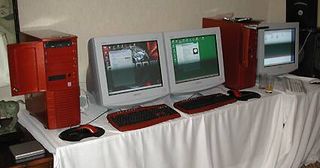ATi Takes Over 3D Technology Leadership With Radeon 9700
Performance Evaluation
Unfortunately, Radeon 9700 is still a few weeks away from its final form, which is why ATi was not supplying test samples to the press. However, to back up the claims in the white papers, ATi allowed us to run tests on a Pentium 4 2.5 GHz system equipped with a Radeon 9700 prototype alongside an identical system equipped with NVIDIA's GeForce4 Ti4600. ATi asked us to refrain from publishing the actual numbers we saw, but to just report our impressions. The three hours of hands on testing did not disappoint us. Here is the performance report of Lars Weinand, our 3D specialist:

There's no denying the fact that the specifications of Radeon 9700 promise a very fast graphics card. While full blown test samples are unfortunately still a few weeks away, we were given the chance to test a prototype and compare its performance to a GeForce4 Ti4600 in an identical system.
Tests showed that Radeon 9700 is clearly superior to NVIDIA's GeForce4 Ti4600, especially once high resolutions, FSAA or anisotropic filtering are used. However, what would you expect from a card with twice the memory bandwidth of its competitor? ATi promises twice the performance of GeForce4 Ti4600 in any game, but that should be considered pure marketing hype. Naturally, it takes high resolutions and full scene anti aliasing to beat NVIDIA's flagship to the punch. CPU-limited games are of course running just as fast on either of the two cards.
Thanks to the superior performance of Radeon 9700 under FSAA and anisotropic filtering, there is hardly any reason left to run games without these features, as the performance penalty is considerably small. ATi's new high-end card beats GeForce4 Ti4600 even in terms of quality, at least when it comes to anti aliasing. The spokes wheel demo spoke a clear language. ATi's new gamma correction feature makes a considerable difference. However, Radeon 9700 doesn't need those quality enhancing features to beat the competitor from NVIDIA. The raw power of R300 makes sure that it scores better even at normal settings.
It is not yet clear if the omission of a second texture unit per pixel rendering pipeline was indeed a smart choice. Under multi texturing conditions, GeForce4 Ti4600 is theoretically able to supply just the same amount of pixels per clock as Radeon 9700. The fill rate test of 3DMark2001 SE hinted in the same direction. The score of Radeon 9700 is very close to the result of GeForce4 Ti4600.
Here are a few numbers for those of you who can't wait. The 3DMark2001SE score of GeForce4 Ti4600 was 11,400, while Radeon 9700, with its young driver, scored 14,000. Once 4x FSAA and 8x anisotropic filtering was used, the scores changed quite significantly. GeForce4 Ti4600 was able to get a mere 4500 points, while Radeon 9700 scored 10,000 points, thus, more than twice the points of the competitor from NVIDIA.
Future games with pixel and vertex shader effects will naturally benefit most from ATi's new flagship card. Supposedly, ATi is expecting 100 games for Christmas 2002 that use DirectX 8 effects. At this time, DirectX 9 will finally be out, and Radeon 9700 will have much tougher competition than it does today. We don't expect DirectX 9 to make much of a difference this year. It is known well enough how long it takes until new features get adopted by game developers.
Stay on the Cutting Edge
Join the experts who read Tom's Hardware for the inside track on enthusiast PC tech news — and have for over 25 years. We'll send breaking news and in-depth reviews of CPUs, GPUs, AI, maker hardware and more straight to your inbox.
There's no denying that right now, Radeon 9700 is way ahead of the competition. It plays in a different performance league than the rest of the graphics cards that are available today. Different to Parhelia, it doesn't take major exploration to find the performance of Radeon 9700. However, in three months NVIDIA is certain to get its revenge. We will see how the upcoming 'NV30' will fare against Radeon 9700. Until then, ATi has all the reason in the world to enjoy its new leadership role.
We will follow up as soon as ATi supplies us with final review samples.
Please follow-up by reading The new mainstream Radeon: The 9000 series .
Most Popular

